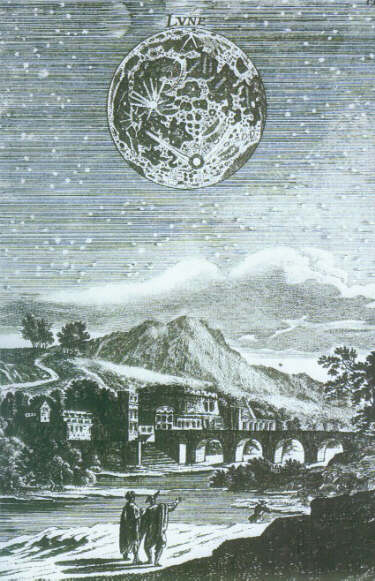 Department
of
Department
of
Science & Technology Studies
University College London
Nicholas Kollerstrom's
Newton's 1702 Lunar Theory
Quest for a Lunar Theory
The main contenders for finding longitude, at the dawn of
the eighteenth century, were the Moon, the moons of Jupiter, or a chronometer.
There were dire problems in detecting the second of these on board a tossing
ship, though they had the advantage of exact adherence to Kepler's laws
of planetary motion in their elliptical motions. Tables of their appearances
from behind the orb of Jupiter were published. Marine chronometers came
into use from the mid-eighteenth-century onwards, but remained prohibitively
expensive for most vessels.
 The
Principia had made the lunar sidereal period of 27.321 days the
crux of its argument about gravity theory. Could that orbit serve as a
universal clock, by comparison with which the longitude
could be found? The problem was that the inequalities in its orbit
seemed to defy analysis. As Halley wrote in his ode prefacing the Principia:
The
Principia had made the lunar sidereal period of 27.321 days the
crux of its argument about gravity theory. Could that orbit serve as a
universal clock, by comparison with which the longitude
could be found? The problem was that the inequalities in its orbit
seemed to defy analysis. As Halley wrote in his ode prefacing the Principia:
At last we learn wherefore
the silver moon
Once seemed to travel
with unequal steps
As if she scorned to
suit her pace to numbers
Till now made clear
to no astronomer.
All of the proposed methods for finding longitude involved
comparing local time with a version of Universal time:
each hour difference between these two indicated fifteen degrees of longitude.
The Earth revolves on its axis twenty-seven times faster than the Moon
takes to orbit. This meant that there was a twenty-seven fold error-multiplication
factor in the lunar method, so that a one arcminute error in lunar position
gave a 27 arcminute error in terrestrial longitude. So, to find terrestrial
longitude within one degree, lunar longitude had to be found within two
arcminutes, ignoring other sources of error (from, eg, atmospheric refraction
and parallax).
The 1714 Act of Longitude offered cash prizes for any
method for finding longitude at sea to within one degree or less. England
was the only nation that ever paid out such a cash prize, awarding part
of it posthumously to Tobias Mayer, or rather to his family, and the rest
to John Harrison, the watchmaker.
Local apparent time could be found on a ship, from times
of sunrise and sunset, and a clock could easily keep that time during a
day. Local mean time was then found by applying an 'Equation of time' -
'the Aequation of the Naturall Days' as Flamsteed called it, which had
a maximum value of seventeen minutes. No such reliable Equation of time
existed until 1673, when Flamsteed published a table of it in a postscript
to Horrock's Opera, then in 1707 Whiston published an improved version
from Flamsteed.

The quadrant was invented in 1731, using a pair of mirrors
to gauge the Sun's height above the horizon. From around 1730 it began
to look as if one of the methods was going to work. To quote from Dava
Sobell, 'In longitude determination, a realm of endeavour where nothing
had worked for centuries, suddenly two rival approaches of apparently equal
merit ran neck and neck'. Perfection of the two methods blazed parallel
trails of development down the decades from the 1730s to the 1760s. John
Harrison, the watchmaker, paid a visit to Edmund Halley in 1730 for advice
on the sea-going chronometer he planned to construct.
The British Nautical Almanac was published from
1767 onwards, giving lunar longitude positions at three-hourly intervals.
Merchant vessels came to adopt the Greenwich meridian for their reference,
as the positions given in the Almanac were for Greenwich time. Ephemerides
of other nations reproduced these positions, as being the best available
(Sadler, 1976). Positional data of the first page of the Nautical almanac
had a mean error of 16"±17" I found, which is in accord with what
was then believed about these tables, ie that they gave longitude within
about 1° (Howse, Nov.1993 p.4).
The contents of this page remain
the copyrighted, intellectual property of Nicholas Kollerstrom. Details.
rev: May 1998 

 The
Principia had made the lunar sidereal period of 27.321 days the
crux of its argument about gravity theory. Could that orbit serve as a
universal clock, by comparison with which the longitude
could be found? The problem was that the inequalities in its orbit
seemed to defy analysis. As Halley wrote in his ode prefacing the Principia:
The
Principia had made the lunar sidereal period of 27.321 days the
crux of its argument about gravity theory. Could that orbit serve as a
universal clock, by comparison with which the longitude
could be found? The problem was that the inequalities in its orbit
seemed to defy analysis. As Halley wrote in his ode prefacing the Principia:
 Department
of
Department
of
